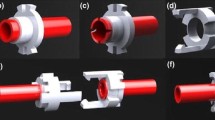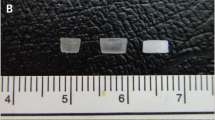Abstract
When performing microsurgeries, the procedure of vascular anastomosis is frequently performed. When executing this procedure, the most widely used method is hand suturing the vessels back together. This process, however, is extremely time consuming (depending on the size and location of the vessel and the experience of the surgeon) and is subject to human error. The vascular coupling device and its accompanying installation tools in this work have been designed and tested to reduce human error and significantly decrease the amount of time required to perform the anastomosis. Tests that were performed on a revised biodegradable vascular coupling device include the time required to complete the anastomosis, a pressure leak test (both open-end and sealed-end), and a tensile test. The coupler was also installed on the carotid arteries of 2 living and 2 cadaver swine. The coupling device was installed in an average of 7 min and 34 s (n = 3), had significantly less leakage than hand sutured anastomoses, and was able to withstand an average tensile force of 8.65 ± 2.55 N (n = 5) before failure.









Similar content being viewed by others
References
Satiani, B., Williams, T. E., & Go, M. R. (2009). Predicted shortage of vascular surgeons in the United States: Population and workload analysis. Journal of Vascular Surgery, 50(4), 946–952.
Calles-Vázquez, M. C., Rubio, E. A., Ayala, V. C., Gargallo, J. U., & Margallo, F. M. S. (2013). Growing cava vein anastomosis: Comparison of cross-clamping and suture times using VCS Metallic clips, interrupted nonabsorbable, or continuous absorbable suturing techniques. Annals of Vascular Surgery, 27(7), 947–953.
Davis, C. R., Rappleye, C. T., Than, P. A., Rodrigues, M., Findlay, M. W., Bishop, S. N., et al. (2016). Sutureless microsurgical anastomosis using an optimized thermoreversible intravascular poloxamer stent. Plastic and Reconstructive Surgery, 137(2), 546–556.
Ferrari, E., Piergiorgio, T., & von Segesser, L. K. (2007). The vascular join: A new sutureless anastomotic device to perform end-to-end anastomosis. preliminary results in an animal model. Interactive Cardiovascular Thoracic Surgery, 6(1), 5–8.
Filsoufi, F., Farivar, R. S., Aklog, L., Anderson, C. A., Chen, R. H., Lichtenstein, S., et al. (2004). Automated distal coronary bypass with a novel magnetic coupler (MVP System). The Journal of Thoracic and Cardiovascular Surgery, 127(1), 185–192.
Gummert, J. F., Opfermann, U., Jacobs, S., Walther, T., Kempfert, J., Mohr, F. W., et al. (2007). Anastomotic devices for coronary artery bypass grafting: Technological options and potential pitfalls. Computers in Biology and Medicine, 37(10), 1384–1393.
Jacobs, S., Mohr, F. W., & Falk, V. (2004). Facilitated endoscopic beating heart coronary bypass grafting using distal anastomotic device. International Congress Series, 1268, 809–812.
Klima, U., Maringka, M., Bagaev, E., Kirschner, S., & Haverich, A. (2004). Total magnetic vascular coupling for arterial revascularization. The Journal of Thoracic and Cardiovascular Surgery, 127(2), 602–603.
Suyker, W. J. L., Buijsrogge, M. P., Suyker, P. T. W., Verlaan, C. W. J., Borst, C., & Gründeman, P. F. (2004). Stapled coronary anastomosis with minimal intraluminal artifact: The S2 anastomotic system in the off-pump porcine model. The Journal of Thoracic and Cardiovascular Surgery, 127(2), 498–503.
Scheltes, J. S., van Andel, C. J., Pistecky, P. V., & Borst, C. (2003). Coronary anastomostic devices: Blood-exposed non-intimal surface and coronary wall stress. The Journal of Thoracic and Cardiovascular Surgery, 126(1), 191–199.
Ueda, K., Mukai, T., Ichinose, S., Koyama, Y., & Takakuda, K. (2010). Bioabsorbable device for small-caliber vessel anastomosis. Microsurgery, 30(6), 494–501.
Yeo, H., Kim, H., Son, D., Hong, C., & Kwon, S. Y. (2017). Vessel remodeling after intima-to-intima contact anastomosis. Archives of Plastic Surgery, 44(2), 95–100.
Bähr, W., Rosbander, R., Gutwald, R., & Scholz, C. (1998). Vascular anastomosis using a biodegradable device with a heat-shrinking sleeve: A preliminary report. Journal of Oral and Maxillofacial Surgery, 56(12), 1404–1409.
Jandali, S., Wu, L. C., Vega, S. J., Kovach, S. J., & Serletti, J. M. (2010). 1000 consecutive venous anastomoses using the microvascular anastomotic coupler in breast reconstruction. Plastic and Reconstructive Surgery, 125(3), 792–798.
Gehrke, C., Li, H., Sant, H., Gale, B., & Agarwal, J. (2014). Design, fabrication and testing of a novel vascular coupling device. Biomedical Microdevices, 16, 173–180.
Li, H., Gale, B. K., Sant, H., Shea, J., & Agarwal, J. (2014). Design, fabrication, and testing of a novel end-to-end vascular coupling system. In IEEE Engineering in Medicine and Biology Society, Chicago.
Li, H., Gale, B. K., Sant, H., Shea, J., Bell, E. D., & Agarwal, J. (2015). A novel vascular coupling system for end-to-end anastomosis. Cardiovascular Engineering and Technology, 6(3), 294–302.
Li, H., Gale, B., Shea, J., Sant, H., Terry, C. M., & Agarwal, J. (2017). Vascular coupling system for end-to-end anastomosis; an in vivo pilot case report. Cardiovascular Engineering and Technology, 8(1), 91–95.
Sommer, G., Regitnig, P., Költringer, L., & Holzapfel, G. A. (2010). Biaxial mechanical properties of intact and layer-dissected human carotid arteries at physiological and supraphysiological loadings. American Journal of Physiology—Heart and Circulatory Physiology, 298(3), H898–H912.
Takashima, K., Shimomura, R., Kitou, T., Terada, H., Yoshinakab, K., & Ikeuchia, K. (2007). Contact and friction between catheter and blood vessel. Tribology International, 40(2), 319–328.
Prokopovich, P., Perni, S., Piccirillo, C., Pratten, J., Parkin, I. P., & Wilson, M. (2010). Frictional properties of light-activated antimicrobial polymers in blood vessels. Journal of Materials Science Materials in Medicine, 21(2), 815–821.
Zhang, M., & Mak, A. F. T. (1999). In vivo friction properties of human skin. Prosthetics and Orthotics International, 23, 135–141.
Shacham, S., Castel, D., & Gefen, A. (2010). Measurements of the static friction coefficient between bone and muscle tissues. Journal of Biomechanical Engineering, 132(8), 084502.
Coimbra, M. E. R., Elias, C. N., & Coelho, P. G. (2008). In vitro degradation of Poly-L-D-lactic acid (PLDLA) pelets and powder used as synthetic alloplasts for bone grafting. Journal of Materials Science Materials in Medicine, 19(10), 3227–3234.
Lidman, D., & Daniel, R. K. (1981). Then normal healing process of microvascular anastomoses. Scandinavian Journal of Plastic and Reconstructive Surgery, 15(2), 103–110.
Acknowledgements
The authors would like to thank Yuxia He for her help in the animal studies as well as Brody King and Alvin Kwok for their help in the time for anastomosis tests. The authors would also like to acknowledge the use of the College of Engineering Nanofabrication Lab at the University of Utah, and the financial support from NIH grant 1R43HL132767 and the Utah Governor’s Office of Economic Development Technology Commercialization Program.
Author information
Authors and Affiliations
Corresponding author
Ethics declarations
Conflict of interest
BKG, HJS, and JA declare a financial interest in Microsurgical Innovations, a company with an intellectual property interest in this technology. This study was approved by the University of Utah IACUC. Animal procedures were conducted at the University of Utah, an AAALAC accredited facility, and followed all national guidelines for the care and use of laboratory animals.
Research Involving Human Participants
No human studies were carried out by the authors for this article.
Rights and permissions
About this article
Cite this article
Brewster, R., Gale, B.K., Sant, H.J. et al. A Biodegradable Vascular Coupling Device for End-to-End Anastomosis. J. Med. Biol. Eng. 38, 715–723 (2018). https://doi.org/10.1007/s40846-017-0348-8
Received:
Accepted:
Published:
Issue Date:
DOI: https://doi.org/10.1007/s40846-017-0348-8




